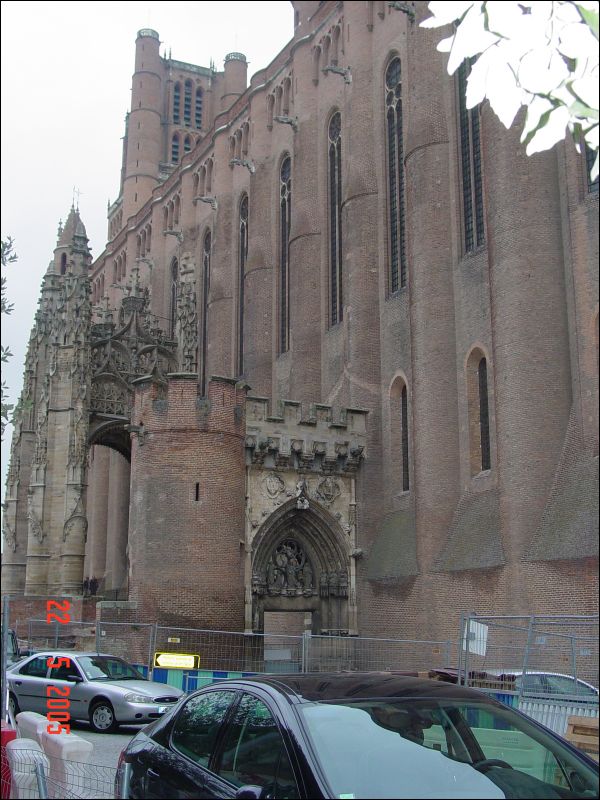Clifford Algebra Conference 2005 (32 of 43)
![[First]](bw_first.gif)
|
![[Prev]](bw_prev.gif)
|
![[Index]](bw_index.gif)
|
![[Next]](bw_next.gif)
|
![[Last]](bw_last.gif)
|

|
Albi, the town with a whiff of infamy to its name. The Albigensian Crusade was a cataclysm of the Middle Ages, a ferocious campaign of siege, battle, and bonfire during which supporters of the Catholic Church sought to eliminate the heretics known as the Albigenses, or the Cathars. That thirteenth-century crusade, directed not against Muslims in distant Palestine but against dissident Christians in the heart of Europe, was followed by the founding of the Inquisition, an implacable machine expressly created to destroy the Cathar survivors of the war. As a result of the upheaval, Languedoc, once a proudly independent territory, was annexed to the kingdom of France. Crusade, Inquisition, conquest - Albi's place in history, if not in fond memory, was assured.
There, looming over a terraced tumble of riverside dwellings, stood a red fortress, monolithic and menacing, a stupendous mountain of bricks piled 100 feet high and 300 feet wide. Sullenly rectangular, its windows little more than elongated slits, the building looked indestructible, like a glowering anvil hurled from the heavens. Its thirty-two buttresses, shaped like smokestacks cut in half lengthwise, ringed the cyclopean walls on all four sides and rose as far as the flat line of an impossibly distant roof. In silhouette, it resembled an appallingly large change dispenser, of the type once worn by bus conductors and waitresses - one buttress holding pennies, another nickels, and so on. Yet that homely comparison was spoiled by an even taller structure, a tower, a red-brick rocket shooting 100 feet higher than the roof alongside the west wall.
The tower held bells that toll on Sunday. The building was a church.
The fearsome oddity that is the Cathedral of Ste-Cecile will never let the townspeople forget their Albigensian connection. Erected from 1282 to 1392, the building is a massive bully that dwarfs and dominates its neighbors. There is no transept; thus the church does not even have the redemptive shape of the cross. For centuries, it had just one small door. Unlike the other great French cathedrals in Paris, Chartres, Rheims, Bourges, Rouen, and Amiens, there were no messy markets under Ste-Secile's soaring vault, no snoring wayfarers on its floor, no livestock droppings to slop out in the mornings, no grand portals to let in the air breathed by ordinary men. The church's exterior was - and still is - a monument to power.
Bernard de Castanet was the medieval bishop who approved the plans, raised the money, and started the construction. As he was doing this in the 1280s, Castanet was also accusing many prominent townspeople of heresy, even though the Albigensian Crusade had ended two generations earlier and the inquisitors had been assiduously intimidating the populace ever since. The bishop's opponents, particularly one outspoken Franciscan friar named Bernard Delicieux, claimed that Castanet was using the threat of Inquisition prisons to silence free men and to extort funds. Whatever the truth, the fortress church rose, brick by unforgiving brick, until its larger message became clear: Submit or be crushed.
There was nothing subtle about the appearance of Ste-Cecile, nothing that demanded a specialized monograph detailing gargoyles, grace notes, and the like. We walked around the hulking giant, marveling that the midafternoon silence of Albi had been so deceptive. The red cathedral was, in the end, an enraged bellow from Bishop Castanet and his successors. They had seen their world - their power, privileges, beliefs - imperiled by the subversive creed of the Cathars, and they had roared out their anger in this monstrous mountain of brick. It filled our eyes and our ears. Only a disagreement over something as fathomless as the soul of a civilization could elicit a shout so loud that it was still audible across a chasm of 700 years. [Stephen O' Shea, The Perfect Heresy: The Revolutionary Life and Death of the Medieval Cathars; 2000, Douglas & McIntyre, Vancouver/Toronto]
![[First]](bw_first.gif)
|
![[Prev]](bw_prev.gif)
|
![[Index]](bw_index.gif)
|
![[Next]](bw_next.gif)
|
![[Last]](bw_last.gif)
|